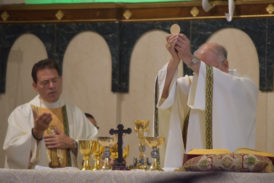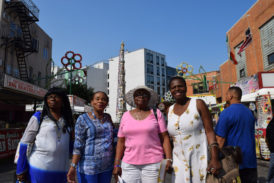The closing Mass for the feast of Our Lady of Mount Carmel took place at its namesake parish in Williamsburg July 16 during the peak of summer, but July’s rising temperatures couldn’t take away from an overflowing congregation – mostly first-generation Italian-Americans and Haitian immigrants from around the diocese. They came to honor their Blessed Mother as a devotion that traces throughout cultural and family traditions.
Bishop Nicholas DiMarzio also has a special relationship to Our Lady of Mount Carmel: He has her statue in his chapel and before he was bishop, was assigned to a church named in her honor in his home diocese of Newark, N.J.
The bishop celebrated Monday’s Mass, which was concelebrated by Msgr. Jamie Gigantiello, pastor; Msgr. Steven Aguggia; Father Joseph Holcomb, pastor of St. Andrew Avellino, Flushing; and Father Tomasz Adamczyk, a visiting priest from Poland. Parish Deacon Philip Franco assisted at the altar.

Throughout his homily, Bishop DiMarzio spoke about the history of Mount Carmel dating back to the Old Testament.
“Mount Carmel is a mountain in Israel,” the bishop said. “Around that mountain, we heard about prophet Elijah from Mount Carmel who tried to bring people back to God… that’s how much he was able to capture the understanding of the one, true God – 900 years before Christ was born.”
He said Elijah gave his assistant Elisha his mantle to show that he was his disciple. That mantle is what the Church understands as the scapular worn by Our Lady of Mount Carmel.
In the church that was standing-room only, many of the faithful adorned their necks with the same scapular – some small and some as big as notebook pads. The bishop spoke about its significance.
Disciples of Mary
“We too are disciples of Mary when we wear our scapular,” he said, “it makes us one of her children. It shows the power we have to evoke God’s name through Mary’s intercession. Our world today certainly is in need of reminding ourselves that pagan times are not gone.”
Msgr. Gigantiello shared the same sentiments as the bishop about asking for Mary’s intercession. Before they moved into the Williamsburg streets for the annual procession with the statue of the Blessed Mother, he expressed his gratitude for those in attendance.
“It’s days like today that bring our faith into the street and brings God back into our world, so I commend you for that,” he said. “I also ask you to make a vow to Our Lady, say the rosary every day until next year and you’ll be surprised at the graces that will come through it.”

After the Mass, some parishioners and guests took part in the annual procession. But some of the elder guests decided to avoid the crowds and wait inside.
One visiting parishioner from St. Cecilia, Greenpoint, Pat Baumbach, said the devotion goes back generations. Her late mother, grandmother and great-grandmother used to walk from Brooklyn to Our Lady of Mount Carmel parish, Manhattan, as part of an annual traditional pilgrimage.
“I still come here in honor of her and her grandmother, who was (named) Carmela,” said Baumbach. “I said if I don’t light the candles, my mother will haunt me for the whole year, so I have to come and it’s a tradition.”
Keeping Tradition Alive
For 88-year-old Carmela Pugliese, the tradition was started by her Italian immigrant parents, who met in the U.S. during the early 1900s. The parishioner at St. Cecilia’s said she likes to keep the tradition alive even though all her siblings have passed.
“We celebrated this holiday with big meals, nobody worked, everybody had to get dressed up like you did for Easter, all the children,” said Pugliese. “…So I like to keep it going even though I’m the youngest. All my brothers and sisters are gone. I still feel it. I still feel a devotion to Our Lady of Mount Carmel.”
As the feast-goers outside church took to the streets and as the food vendors set up their array of Italian sausages and peppers, more parishioners from the Haitian community started entering the church. One group came from Sacred Heart parish, Cambria Heights. They said they were saving their seats three hours before the evening Mass in Haitian Creole with retired Auxiliary Bishop Guy Sansaricq.
The Haitian community shares a similar devotion to Our Lady of Mount Carmel. A family who attends the Co-Cathedral of St. Joseph, Prospect Heights, attended the afternoon Mass.
“You’ll see how much love we have,” said Martine Michel, who brought her daughter for the first time. “We come every year to Mount Carmel to pay our respects and be a part of her festivities every year.”
For Marlie Leopold, her family tradition traces to Our Lady of Mount Carmel parish in the central Haitian town of Ville-Bonheur, where the Blessed Mother is its patron saint. Every year, pilgrims visit the mountains of Saut-d’Eau, which means waterfall in French.
“From the time I was young, I remember my mom used to go, so I’ve always adopted it and I’m a strong believer of the Holy Mother,” said Leopold, a parishioner at St. Jude, Canarsie.
“They used to go Saut-d’Eau, way up in the mountains. It’s far from the city back home. They used to go there on this day. It’s very, very, very important to people in Haiti.”

































